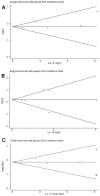Insulin therapy and risk of prostate cancer: a systematic review and meta-analysis of observational studies
- PMID: 24282613
- PMCID: PMC3839878
- DOI: 10.1371/journal.pone.0081594
Insulin therapy and risk of prostate cancer: a systematic review and meta-analysis of observational studies
Abstract
Background: Previous observational studies have shown that insulin therapy may modify the risk of prostate cancer (PCa). However, these studies yielded controversial results. Thus, we performed this meta-analysis to determine whether insulin use was associated with PCa risk in patients with diabetes mellitus (DM).
Method: A literature search was carried out in PubMed, EMBASE, and Cochrane Library Central database between January 1966 and January 2013. Fixed-effect and random-effect models were used to estimate pooled relative risks (RR) and corresponding 95% confidence intervals (CIs). Subgroup analyses and sensitivity analyses were also performed.
Result: A total of 11 (10 cohorts, and one case-control) studies published between 2007 and 2013 were included in the meta-analysis, representing data for 205,523 male subjects and 7,053 PCa cases. There were five studies investigating the influence of insulin and other glucose-lowering agents on the risk of PCa , and six studies investigating the influence of glargine and non-glargine insulin. Insulin use was not associated with PCa risk when compared with other glucose-lowering agents (RR=0.89, 95% CI, 0.72-1.09). Use of insulin glargine did not contribute to susceptibility to PCa as compared with use of non-glargine insulin (RR=1.26, 95% CI, 0.86-1.84). Sensitivity analysis confirmed the stability of present results, since no individual study affected the pooled result significantly.
Conclusions: Our results suggest that, there may be no significant association between insulin use and risk of PCa as compared with other glucose-lowering agents in patients with DM, and there was no substantial evidence for increase risk of PCa among insulin glargine users as compared to non-glargine insulin users. Further studies are warranted to validate these conclusions.
Conflict of interest statement
Figures




Similar articles
-
Oral anti-diabetic agents for women with established diabetes/impaired glucose tolerance or previous gestational diabetes planning pregnancy, or pregnant women with pre-existing diabetes.Cochrane Database Syst Rev. 2017 Oct 18;10(10):CD007724. doi: 10.1002/14651858.CD007724.pub3. Cochrane Database Syst Rev. 2017. PMID: 29045765 Free PMC article.
-
Systemic pharmacological treatments for chronic plaque psoriasis: a network meta-analysis.Cochrane Database Syst Rev. 2021 Apr 19;4(4):CD011535. doi: 10.1002/14651858.CD011535.pub4. Cochrane Database Syst Rev. 2021. Update in: Cochrane Database Syst Rev. 2022 May 23;5:CD011535. doi: 10.1002/14651858.CD011535.pub5. PMID: 33871055 Free PMC article. Updated.
-
Screening for prostate cancer.Cochrane Database Syst Rev. 2013 Jan 31;2013(1):CD004720. doi: 10.1002/14651858.CD004720.pub3. Cochrane Database Syst Rev. 2013. PMID: 23440794 Free PMC article.
-
Sertindole for schizophrenia.Cochrane Database Syst Rev. 2005 Jul 20;2005(3):CD001715. doi: 10.1002/14651858.CD001715.pub2. Cochrane Database Syst Rev. 2005. PMID: 16034864 Free PMC article.
-
Systemic pharmacological treatments for chronic plaque psoriasis: a network meta-analysis.Cochrane Database Syst Rev. 2017 Dec 22;12(12):CD011535. doi: 10.1002/14651858.CD011535.pub2. Cochrane Database Syst Rev. 2017. Update in: Cochrane Database Syst Rev. 2020 Jan 9;1:CD011535. doi: 10.1002/14651858.CD011535.pub3. PMID: 29271481 Free PMC article. Updated.
Cited by
-
Glycemic Control and Prostate Cancer Mortality Risk in Veterans with Type 2 Diabetes Mellitus.Cancer Res Commun. 2025 Aug 1;5(8):1256-1265. doi: 10.1158/2767-9764.CRC-25-0037. Cancer Res Commun. 2025. PMID: 40693585 Free PMC article.
-
Systematic review and meta-analysis of randomized clinical trials comparing efficacy and safety outcomes of insulin glargine with NPH insulin, premixed insulin preparations or with insulin detemir in type 2 diabetes mellitus.Acta Diabetol. 2015 Aug;52(4):649-62. doi: 10.1007/s00592-014-0698-4. Epub 2015 Jan 14. Acta Diabetol. 2015. PMID: 25585592 Free PMC article.
-
Pharmacologic Therapy of Diabetes and Overall Cancer Risk and Mortality: A Meta-Analysis of 265 Studies.Sci Rep. 2015 Jun 15;5:10147. doi: 10.1038/srep10147. Sci Rep. 2015. PMID: 26076034 Free PMC article.
-
Antidiabetic drugs influence molecular mechanisms in prostate cancer.Cancer Biol Ther. 2018;19(12):1153-1161. doi: 10.1080/15384047.2018.1491490. Epub 2018 Aug 1. Cancer Biol Ther. 2018. PMID: 30067448 Free PMC article.
-
Association of type 2 diabetes mellitus and antidiabetic medication with risk of prostate cancer: a population-based case-control study.BMC Cancer. 2020 Jun 15;20(1):551. doi: 10.1186/s12885-020-07036-4. BMC Cancer. 2020. PMID: 32539807 Free PMC article.
References
-
- Danaei G, Finucane MM, Lu Y, Singh GM, Cowan MJ et al. (2011) National, regional, and global trends in fasting plasma glucose and diabetes prevalence since 1980: systematic analysis of health examination surveys and epidemiological studies with 370 country-years and 2.7 million participants. Lancet 378: 31-40. doi:10.1016/S0140-6736(11)60679-X. PubMed: 21705069. - DOI - PubMed
Publication types
MeSH terms
Substances
LinkOut - more resources
Full Text Sources
Other Literature Sources
Medical

